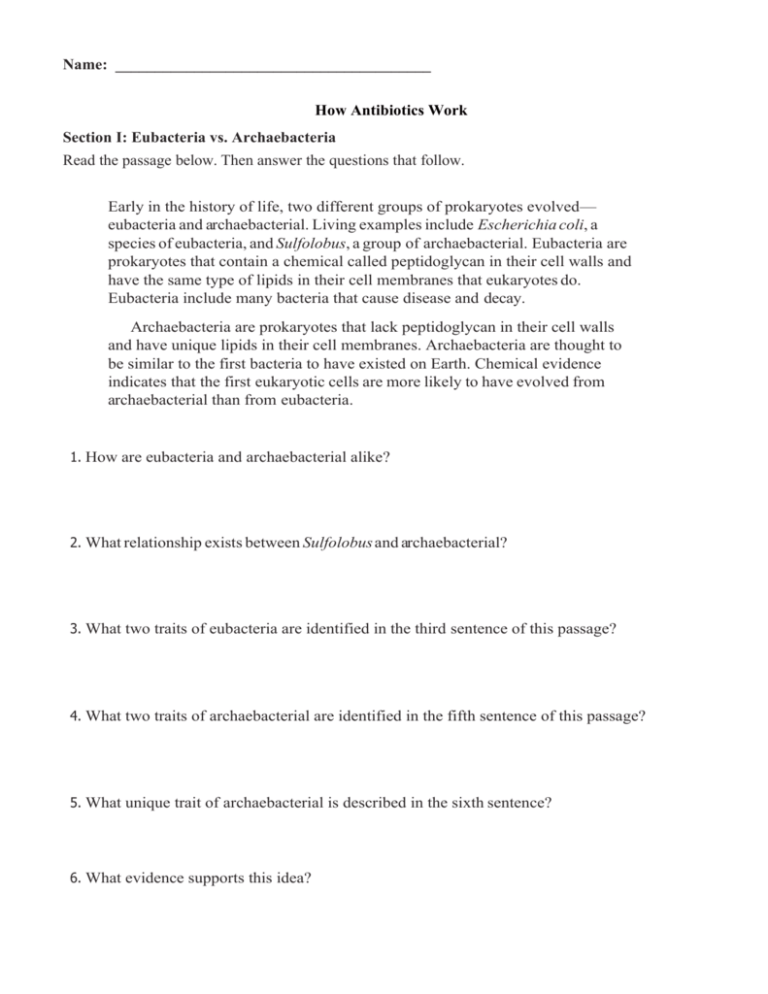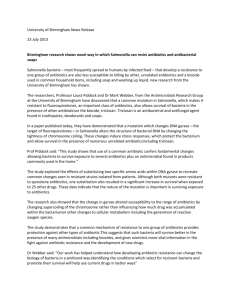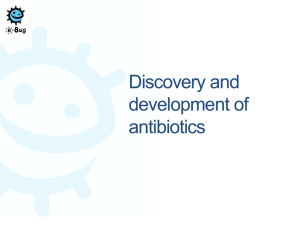How Antibiotics Work
advertisement

Name: ________________________________________ How Antibiotics Work Section I: Eubacteria vs. Archaebacteria Read the passage below. Then answer the questions that follow. Early in the history of life, two different groups of prokaryotes evolved— eubacteria and archaebacterial. Living examples include Escherichia coli, a species of eubacteria, and Sulfolobus, a group of archaebacterial. Eubacteria are prokaryotes that contain a chemical called peptidoglycan in their cell walls and have the same type of lipids in their cell membranes that eukaryotes do. Eubacteria include many bacteria that cause disease and decay. Archaebacteria are prokaryotes that lack peptidoglycan in their cell walls and have unique lipids in their cell membranes. Archaebacteria are thought to be similar to the first bacteria to have existed on Earth. Chemical evidence indicates that the first eukaryotic cells are more likely to have evolved from archaebacterial than from eubacteria. 1. How are eubacteria and archaebacterial alike? 2. What relationship exists between Sulfolobus and archaebacterial? 3. What two traits of eubacteria are identified in the third sentence of this passage? 4. What two traits of archaebacterial are identified in the fifth sentence of this passage? 5. What unique trait of archaebacterial is described in the sixth sentence? 6. What evidence supports this idea? An analogy is a comparison. In the space provided, write the letter of the term or phrase that best completes the analogy. 7. Archaebacteria is to Sulfolobus as eubacteria is to a. Escherichia coli. b. cyanobacteria. c. peptidoglycan. d. Both (a) and (b) Section II: How do antibiotics kill bacterial cells but not human cells? March 13, 2006 Harry Mobley, chair of the department of microbiology and immunology at the University of Michigan Medical School, provides this answer. (Downloaded from http://www.scientificamerican.com/article/how-do-antibiotics-kill-b; Oct 5, 2015) In order to be useful in treating human infections, antibiotics must selectively target bacteria for eradication and not the cells of its human host. Indeed, modern antibiotics act either on processes that are unique to bacteria-such as the synthesis of cell walls or folic acid--or on bacterium-specific targets within processes that are common to both bacterium and human cells, including protein or DNA replication. Following are some examples. Most bacteria produce a cell wall that is composed partly of a macromolecule called peptidoglycan, itself made up of amino sugars and short peptides. Human cells do not make or need peptidoglycan. Penicillin, one of the first antibiotics to be used widely, prevents the final cross-linking step, or transpeptidation, in assembly of this macromolecule. The result is a very fragile cell wall that bursts, killing the bacterium. No harm comes to the human host because penicillin does not inhibit any biochemical process that goes on within us. Bacteria can also be selectively eradicated by targeting their metabolic pathways. Sulfonamides, such as sulfamethoxazole, are similar in structure to para-aminobenzoic acid, a compound critical for synthesis of folic acid. All cells require folic acid and it can diffuse easily into human cells. But the vitamin cannot enter bacterial cells and thus bacteria must make their own. The sulfa drugs such as sulfonamides inhibit a critical enzyme-dihydropteroate synthase--in this process. Once the process is stopped, the bacteria can no longer grow. 1. What is the most important consideration in developing a drug to work against bacterial infections? 2. What are two specific targets that the drug can act against? 3. Describe a structural characteristic that is unique to eubacteria. 4. How does a sulfonamide work? Antibiotics - How They Work Antibiotics work by being either bactericidal where they kill microorganisms; or by being bacteristatic where they inhibit the growth of the microorganisms. An example of a bactericidal antibiotic is Penicillin. This works by preventing the production of a substance that form the cell wall: peptidoglycan. This means the cell will continue to grow without dividing or developing new cell wall. Therefore, the wall gets weaker, and eventually ruptures (lysis). Other antibiotics work by inhibiting the protein synthesis or nucleic acid synthesis. Tetracycline is a bacteristatic antibiotic that binds to ribosomes in bacteria, this means the cell cannot make proteins and therefore can't grow. When choosing antibiotics to treat diseases, it is important to think carefully. For instance, bacteria have a different type of ribosome (70S) to humans (80S), therefore they will only work to target the bacteria and not affect the patient. Narrow spectrum antibiotics target specific reaction in particular microorganisms; whereas broad spectrum antibiotics will have an effect on more general features so affect a wide range of pathogens. Antibiotic Resistance Antibiotic resistance arises as a result of natural selection. Since bacteria reproduce rapidly, resistance can arise quickly. Those antibiotics resistant will remain after treatment and can continue to divide. An example of antibiotic resistance can be seen with Penicillin, some bacteria can produce an enzyme called Penicillinase which breaks down Penicillin before it can take effect. Other mechanisms of resistance include the evolution of a capsule that is resistant to antibiotic, and cell membranes becoming less permeable to antibiotic. Bacteria can spread resistance genes between each other by bacterial conjugation where two cells join by their pilli and exchange plasmids which often contain genes for antibiotic resistance. Antibiotic resistance is made much worse by the overuse of antibiotics in medical treatment. Some bacteria are resistant to most antibiotics (MRSA or mycobacterium-tuberculosis) meaning it is increasingly difficult to treat infection unless new antibiotics are developed. 1. Compare and contrast: bactericidal and bacteriostatic. 2. Explain how penicillin works. 3. Explain how tetracycline works. 4. Both prokaryotic cells and eukaryotic cells have ribosomes. How can a drug specifically affect the workings of the prokaryotic ribosome and not the eukaryotic ribosome? 5. What is the difference between narrow spectrum antibiotics and broad spectrum antibiotics? 6. Explain (be very specific with examples) how natural selection has affected the use of antibiotics in the treatment of bacterial infections.






